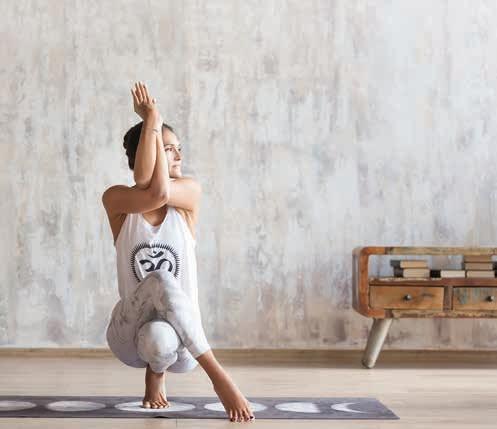
4 minute read
BALANCING ACT
fit body
BALANCING ACT Exercises for Strength and Stability
Advertisement
by Marlaina Donato
Good balance is something we may take for granted until an unexpected fall brings our attention to a brewing problem. Slower reflexes, unconditioned muscles and changes in eyesight can all compromise balance. Statistics show at least one in three people over the age of 65 suffer from injuries related to falls, but regular core-strengthening balance training, yoga and tai chi can lower the risk considerably.
Marching in place and simple exercises added to a customary after-dinner walk on summer evenings can also go a long way. According to a 2013 study of senior women published in the British Journal of Sports Medicine, exercising not only reduces the likelihood of falls by 37 percent, but also the severity of injuries such as broken bones by 61 percent.
“Balance is a skill, and like any skill, it gets better with practice,” says Mike Ross, a Chicago-based performance enhancement specialist and author of The Balance Manual. “The problem is people gradually spend less and less time standing and moving around—chasing kids or doing yard work—and spend more time watching television or sitting in front of the computer.”
Whole Body Equilibrium
Balance training for all ages helps the body to move fluidly as a singular, balanced unit. Stephanie Mansour, a Chicago fitness expert and host of the PBS weekly Step it Up with Steph show, says, “Some people who have hip or back pain may have an imbalance: One side is more developed than the other. Other people may feel wobbly during workouts or walking upstairs, or less agile while getting in and out of cars; doing everyday movements. Balance training will help improve those everyday activities.”
Full-body exercises engage core muscles to stabilize movement. “You’ll be surprised by some muscles that are triggered that are otherwise less engaged during traditional exercises. No matter where you start, it only takes a few minutes of balance work a day to make a difference,” says Los Angeles fitness trainer Kollins Ezekh, emphasizing the added benefit of improved posture that naturally reduces lower back stress and resulting chronic pain.
Balance training also packs a positive punch for brain health by focusing the mind and improving cognitive function while lowering stress levels.
Everyday Activity
Being proactive throughout the day and adopting simple habits have far-reaching effects. “Start in the morning when you’re getting dressed for the day and pay attention to which foot you balance on first to put your legs in your pants. Consciously do the opposite. When you’re drying your hair or brushing your teeth, balance on your tip toes,” suggests Mansour.
Ross recommends staying active in the daily routines. “Make a point of breaking up long periods of sitting like desk work and [watching] television. Get up and play with the kids instead of watching them. If you can, do your own housecleaning and yard work instead of hiring someone. Find a sport that you can engage in as you age. For instance, you might play tennis in your 20s and 30s and then pickleball and Ping-Pong in your 50s.”
No matter what type of training we choose, there’s a way to fit in balance elements. “You can try yoga, where the different poses really challenge your balance strength,” says Ezekh. “When doing weight training, you can do lateral exercises with dumbbells on your shoulders or even squatting movements. You need to use your balance strength to prevent yourself from swaying or toppling over. Even exercises like walking down steps require proper levels of balance.”
A Steady Diet
Vitamin B 12 -rich foods, including wholegrain cereals, plant-sourced milks, eggs, sardines and nutritional yeast, as well as resveratrol-rich fruits like grapes or blueberries, can help improve coordination and motor function. A 2016 study published in the Journal of Physical Therapy Science reveals that women over 60 with higher serum vitamin D levels exhibit better stability and strength in their lower extremities.
Overall, fostering good balance pays off in the long run. Ross notes, “Ideally, the time to start proactively doing activities that stimulate your balance is way before that first fall in your 50s and 60s.”
Marlaina Donato is the author of several books and a recording artist. Connect at AutumnEmbersMusic.com.
featured yoga studio shefayoga Roosevelt
Leah Zaccaria, Owner 206-729-2561 • info@ShefaYoga.com ShefaYoga.com Our mission: “shefa” means abundance in Hebrew and “to heal” in Arabic; we believe there is enough for everyone and we can all be successful emotionally, spiritually and physically. Believing in abundance leads to an attitude of gratitude which leads to overall happiness. We offer daily heated yoga classes taught by experienced Hot Hatha and Power Vinyasa instructors. Our studio features an infrared heating system and an abundance of natural light. Our classes are suitable for all levels.

UPCOMING EVENTS
Check website at ShefaYoga.com for current offerings.
Your Market is Our Readers. Let Us Introduce You to Them!

To advertise in our next issue, call 206-818-5932








